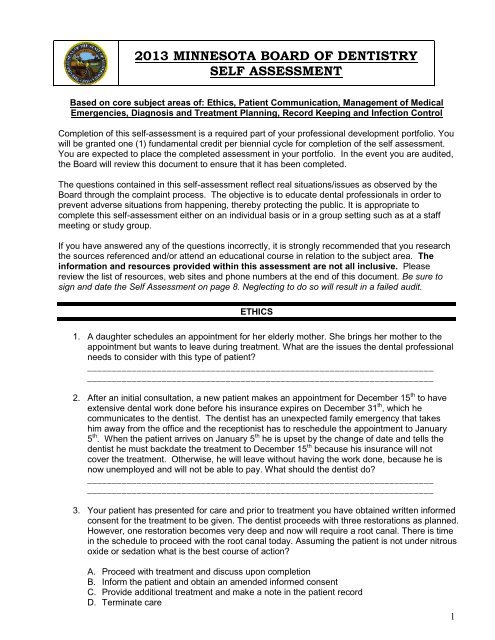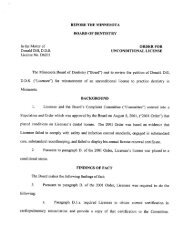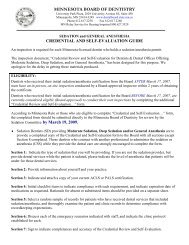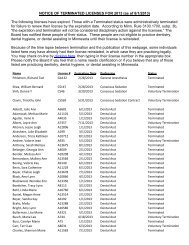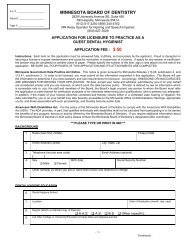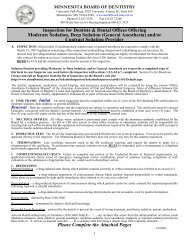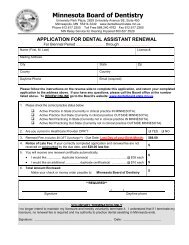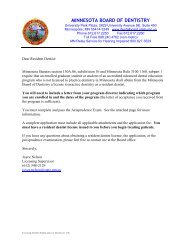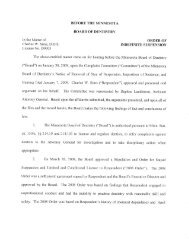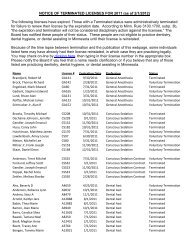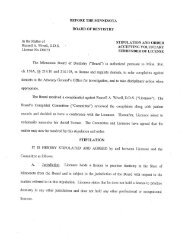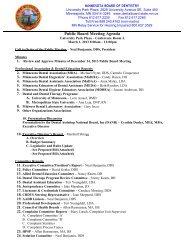2013 MINNESOTA BOARD OF DENTISTRY SELF ASSESSMENT
2013 MINNESOTA BOARD OF DENTISTRY SELF ASSESSMENT
2013 MINNESOTA BOARD OF DENTISTRY SELF ASSESSMENT
- No tags were found...
Create successful ePaper yourself
Turn your PDF publications into a flip-book with our unique Google optimized e-Paper software.
<strong>2013</strong> <strong>MINNESOTA</strong> <strong>BOARD</strong> <strong>OF</strong> <strong>DENTISTRY</strong><strong>SELF</strong> <strong>ASSESSMENT</strong>Based on core subject areas of: Ethics, Patient Communication, Management of MedicalEmergencies, Diagnosis and Treatment Planning, Record Keeping and Infection ControlCompletion of this self-assessment is a required part of your professional development portfolio. Youwill be granted one (1) fundamental credit per biennial cycle for completion of the self assessment.You are expected to place the completed assessment in your portfolio. In the event you are audited,the Board will review this document to ensure that it has been completed.The questions contained in this self-assessment reflect real situations/issues as observed by theBoard through the complaint process. The objective is to educate dental professionals in order toprevent adverse situations from happening, thereby protecting the public. It is appropriate tocomplete this self-assessment either on an individual basis or in a group setting such as at a staffmeeting or study group.If you have answered any of the questions incorrectly, it is strongly recommended that you researchthe sources referenced and/or attend an educational course in relation to the subject area. Theinformation and resources provided within this assessment are not all inclusive. Pleasereview the list of resources, web sites and phone numbers at the end of this document. Be sure tosign and date the Self Assessment on page 8. Neglecting to do so will result in a failed audit.ETHICS1. A daughter schedules an appointment for her elderly mother. She brings her mother to theappointment but wants to leave during treatment. What are the issues the dental professionalneeds to consider with this type of patient?____________________________________________________________________________________________________________________________________________2. After an initial consultation, a new patient makes an appointment for December 15 th to haveextensive dental work done before his insurance expires on December 31 th , which hecommunicates to the dentist. The dentist has an unexpected family emergency that takeshim away from the office and the receptionist has to reschedule the appointment to January5 th . When the patient arrives on January 5 th he is upset by the change of date and tells thedentist he must backdate the treatment to December 15 th because his insurance will notcover the treatment. Otherwise, he will leave without having the work done, because he isnow unemployed and will not be able to pay. What should the dentist do?____________________________________________________________________________________________________________________________________________3. Your patient has presented for care and prior to treatment you have obtained written informedconsent for the treatment to be given. The dentist proceeds with three restorations as planned.However, one restoration becomes very deep and now will require a root canal. There is timein the schedule to proceed with the root canal today. Assuming the patient is not under nitrousoxide or sedation what is the best course of action?A. Proceed with treatment and discuss upon completionB. Inform the patient and obtain an amended informed consentC. Provide additional treatment and make a note in the patient recordD. Terminate care1
4. Your patient has been given local anesthesia and during treatment starts to exhibit signs of asevere allergic reaction. Staff dials 911 and patient is ultimately transported to the hospital.Are you obligated to complete the adverse reaction report?A. YesB. No2
PATIENT COMMUNICATION1. Upon request, a provider shall supply to a patient, complete and current informationpossessed by that provider concerning any diagnosis, treatment and prognosis of the patientin terms and language the patient can reasonably be expected to understand.A. TrueB. False2. A licensed health care provider must wear a name tag which indicates by words, lettersabbreviations, or insignia, the profession or occupation of the individual unless wearing thename tag would create a safety or health risk to the patient.A. TrueB. False3. It is acceptable to state in your advertising for your dental practice that you are a specialist inplacing implants and cosmetic dentistry because you have completed a continuing educationcourse with a minimum number of 12 credits in the related practices.A. TrueB. False4. The license renewal only shall be conspicuously displayed in every office in which that(licensed) person practices, in plain sight of patients.A. TrueB. FalseMANAGEMENT <strong>OF</strong> MEDICAL EMERGENCIES1. Which of these medical emergencies is most likely to happen in your dental practice?A. Mild allergyB. AnginaC. SyncopeD. Seizure2. What are the minimum contents of a medical emergency kit?____________________________________________________________________________________________________________________________________________3. How many regulated dental professionals within the clinic need to be healthcare providerCPR certified?______________________________________________________________________3
DIAGNOSIS AND TREATMENT PLANNING1. When completing an initial oral exam for a child, a panoramic radiograph or full mouthradiographic series for a child is not typically warranted until:A. 7 years of ageB. 9 years of ageC. The first permanent tooth has eruptedD. The 2 nd permanent bicuspid has erupted2. Deep sedation is characterized by impairment of the patient’s ability to independentlymaintain ventilator function, spontaneous ventilation potentially being inadequate to meet thepatient’s needs, andA. The need for a signed informed consent formB. The need for cardiovascular supportC. The need for assistance in maintaining a patent airwayD. The need for use of intravenous reversal agents3. Certification in nitrous oxide administration is the primary board requirement forconscious/moderate sedation.A. TrueB. FalseRECORD KEEPING1. A patient consent to release records is typically valid for three years.A. TrueB. False2. How do you correct an error in an electronic record?____________________________________________________________________________________________________________________________________________3. I noticed in Sunday’s obituary that my long time patient of record had passed away thereforeI can destroy the patient’s record.A. TrueB. False4
4. The Board of Dentistry’s recordkeeping rule (MR 3100.9600) details the elements that mustbe contained in every patient record. For this part of the Self-Assessment, please use thefollowing:Recordkeeping Checklist (copy on page 6), you may make copies as needed.2 current patient recordsFor each patient record, utilize the CHECKLIST to determine whether each elementidentified on the list is documented in that record. If you are not in clinical practice and donot have access to patient records, we recommend you review this form and becomefamiliar with the Minnesota record keeping rule.Examples of minimal recordkeeping (the record must include at least the following):Personal Data Patient Name Patient Address Patient’s Birthdate Patient’s Parent or Guardian Name (if patient is a minor) Emergency Contact Name and Phone Number Insurance Carrier and Identification Number (if applicable)Patient’s Reason for Visit Chief ComplaintDental and Medical History Sufficient Information to Support Recommended Treatment PlanClinical Examination(s)[note: when an emergency treatment is performed, the following items may pertain only to the area treated] Recording of Existing Oral Health Care Status Any radiographs/Images Used, and Facsimiles or Results of any Other Diagnostic Aids UsedDiagnosis: must be documentedTreatment Plan Agreed-Upon Written and Dated Treatment Plan (except for routine dental care such as preventive services) Treatment Plan Updated to Reflect Current Status of Patient’s Oral Health and TreatmentInformed ConsentNotation in Chart that: Dentist or Dental Therapist Discussed Treatment Options and Prognosis, Benefits, & Risks of Each with thePatient, and Patient has Consented to the Treatment ChosenProgress Notes Chronology of Patient’s Progress Throughout the Course of All Treatment and Postoperative Visits All Treatment Provided Clearly Identify the Provider by Name/Initials Identify ALL Medications Used and Materials PlacedMiscellaneous Each Patient Must have a Separate Chart Chart Entries Must be Recorded in INK (no pencils!) Chart Entries Must be Legible Corrections Made by Drawing a Single Line Through Incorrect Information and InitialingElectronic Records All Requirements above Apply to Electronic Records, as well A Duplicate Hard Copy Record Must be Kept, or the Electronic Record Must be Unalterable5
PATIENT INITIALS:_________RECORDKEEPINGCHECKLISTRequirements pre Minn. R. 3100.9600Patient information:Subp. 3. PERSONAL DATA.A. NameB. AddressC. Date of birthD. If minor, name of parent or guardianE. Name/Phone of person to contact if an emergencyF. Name of insurance carrier / insurance ID #.PresentNotPresentNotApplicableCommentsSubp. 4. REASON FOR VISIT.Subp. 5. DENTAL HISTORY.(Data support tx plan?)Subp. 5. MEDICAL HISTORY.(Data support tx plan?)Subp. 6. CLINICAL EXAM INFORMATION:A. Record of existing oral health status.B. Radiographs used.C. Facsimiles or results of any other diagnostic aids.Subp. 7. DIAGNOSIS.Subp. 8. TREATMENT PLAN. Agreed upon Dated (when non-routine/preventive visit) Updated to reflect current status of pt’s oralhealth/treatment.Subp. 9. INFORMED CONSENT.Shall include notation that:A. Dentist discussed tx options/ prognosis /risks / benefitsB. The patient consent to treatment chosen.Subp. 10. PROGRESS NOTES INFORMATION: Chronology of treatment / visits. Identify provider by name or initials. Identify all medications used. Identify all materials placed.Subp. 10. CORRECTIONS MADE PROPERLY.6
INFECTION CONTROL1. Prior to treating a patient, the following procedures should be performed. What is the properorder?A. Acceptable hand hygiene technique along with thorough drying with a disposable toweland gloving with single-use glovesB. Protective eyewear/ face shield and clothing (e.g. long sleeved gowns, lab coat or clinicjackets)C. Surgical mask-covering both nose and mouth2. If the hands of a Dental Health-Care Personnel (DHCP) are visibly dirty or contaminated orare visibly soiled with blood or other body fluids an alcohol-based hand rub is adequate.A. TrueB. False3. Artificial fingernails or extenders have been implicated in multiple outbreaks of fungal andbacterial infectionsA. TrueB. False4. Extracted teeth are considered infectious waste. Therefore, extracted teeth containingamalgam should be placed in a medical waste container and autoclaved or incinerated.A. TrueB. False5. How long should hand pieces, ultrasonic scalers, and air/water syringes be flushed at thestart of the day and between each patient?A. 5-10 secondsB. 10-20 secondsC. 20-30 secondsD. 30-40 seconds7
6. A licensed dental assistant is cleaning the operatory following a dental procedure. During theprocess of disassembling the used syringe, the cap on the needle comes off and theassistant is poked with the used needle. What steps should be taken?________________________________________________________________________________________________________________________________________________________________________________________________I, ____________________________________________________ attest to the MinnesotaBoard of Dentistry that I have completed this self assessment on______________(date)_____________________________________________________(Signature)Rev 12/20128
<strong>SELF</strong> <strong>ASSESSMENT</strong> ANSWERSETHICS1. The health care professional needs to check with the patient to see if they are responsible fortheir own care or determine if there is a legal guardian. If there is a legal guardian, writecontact information in the chart so as to obtain informed consent prior to providing treatmentor in the event treatment changes.Reference: Minnesota Rule 3100.9600 Subp 92. The patient record and billings must reflect actual date(s) of treatment. Improper billing couldbe construed as fraud and is a violation of board and insurance regulations.Reference: Minnesota Rule 3100.6200 H and I3. B. Inform the patient and obtain an amended informed consent.You must receive informed consent before proceeding with the procedure and document it inthe chart. Informed consent is specific to a procedure, where options were given includingprognosis, risks and benefits, and the patient has consented to the treatment chosen.4. Yes.Reference: Minnesota Rule 3100.9600 Subp 9Minnesota Rule 3100.3600 requires that you file the adverse reaction report for any incidentthat arises from the administration of local anesthesia, nitrous oxide inhalation analgesia or ofa pharmacological agent for the purpose of general anesthesia, conscious sedation,analgesia or anxiolysis that results in a serious or unusual outcome that produces atemporary or permanent physiological injury, harm or other detrimental effects to one or moreof a patient’s body system(s). A dentist, dental therapist, dental hygienist, or a licenseddental assistant MUST report within ten business days to the board any incident by anylicensed health care professional who, under contract or employment with the dentist, wasthe actual person administering the analgesia or pharmacological or nonpharmacologicalmethod.Reference: Minnesota Rule 3100.3600 Subp 8 A and B.PATIENT COMMUNICATION1. A. True.2. A. True.Reference: Minnesota Statute 144, Patient Rights, 144.292, Subd. 2Patients have a right to know who is providing their care. Occasionally, despite introductionsmade, a patient may not understand or remember your name.Reference: Minnesota Statute 144.65859
3. B. False.The only board recognized specialty practices are: endodontics, oral and maxillofacialsurgery, oral pathology, orthodontics, pediatric dentistry, periodontics, prosthodontics andpublic health.4. B. False.Reference: Minnesota Rule 3100.7000 Subp 1,2 and 3The initial license and subsequent renewal certificate of every dentist, dental therapist, dentalhygienist, or dental assistant shall be conspicuously displayed in every office in which thatperson practices, in plain sight of patients. The board shall allow the display of a wallet-sizedinitial license and wallet-sized subsequent renewal certificate only at nonprimary practicelocations.Reference: Minnesota Statute 150A.06, Subd 6MANAGEMENT <strong>OF</strong> MEDICAL EMERGENCIES1. C. Syncope.The seven most common medical emergencies in the dental office are syncope, mild allergicreaction, angina pectoris, postural hypotension, seizures, asthmatic attack andhyperventilation.Reference: Academy of General DentistryStanley F. Malamed, Medical Emergencies in the Dental Office, 6 th ed. 20072. Oxygen, Epinephrine, Benadryl, Inhaler, Nitroglycerin, Ammonia inhalants, Glucose source,Ventilation device and blood pressure cuff and stethoscope.It is also advised to frequently check expiration dates and know how to use each item in theemergency kit.2000Reference: Stanley F. Malamed, Medical Emergencies in the Dental Office, 5 th ed3. All regulated dental professional are required to have and maintain current healthcareprovider CPR certification as a condition of licensure. The course for healthcare providermust include: cardiopulmonary resuscitation on an adult, child, and infant; two personrescuer; barrier mask or bag for ventilation; foreign body airway obstruction; and automatedexternal defibrillation. A CPR certificate shall be obtained through the American HeartAssociation healthcare provider course or the American Red Cross professional rescuercourse.Reference: Minnesota Rules 3100.0100 Subp 9a3100.5100 Subp 3 A (3)3100.1700 Subp 210
DIAGNOSIS AND TREATMENT PLANNING1. C. The first permanent tooth has erupted.There is no evidence-based support for completing comprehensive radiographic surveyson young children until eruption of the first of the child’s permanent teeth, unless there isa specific concern regarding the individual patient. The patient record should alwaysinclude rationale for any radiograph, and additional explanation when it varies from thestandard.Reference: American Academy of Pediatric Dentistry Guidelines 20122. C. The need for assistance in maintaining a patent airway.3. B. False.Deep sedation is a depressed level of consciousness during which patients cannot beeasily aroused, but do respond purposefully following repeated or painful stimulation.The definition of deep sedation, which distinguishes this level of sedation from mild andmoderate sedation, addresses the patient’s status as requiring assistance maintaining anairway.Reference: Minnesota Rule 3100.0100 Definitions, Subp 9bModerate sedation, often referred to as conscious sedation, requires that the dentistproviding the sedation services complete extensive training and obtain certification from theBoard of Dentistry. The use of nitrous oxide, on its own or together with other medications orsubstances, may on occasion result in the patient reaching a level of moderate sedation,which would require that the dentist be certified in both nitrous oxide and conscious/moderatesedation.Reference: Minnesota Rule 3100.3600, Subp 3RECORD KEEPING1. B. False.In general, a release of records consent must be signed by an authorized individual and isvalid for 1 year from the date of signature. Minnesota Statute does allow for exceptions.Reference: Minnesota Statute 144.293, Subd 2, 4, 5 and 62. Note new date, state the correction and place initials or if computer allows draw a linethrough the error and initial it.Reference: Minnesota Rules 3100.9600 Subp 1211
3. B. FalseYou will need to check the last treatment date. A dentist shall maintain a patient’s dentalrecords for at least seven years beyond the time the dentist last treated the patient. In thecase of a minor patient, a dentist shall maintain the patient’s dental record for at leastseven years past the age of majority.Reference: Minnesota Rules 3100.9600 Subp 124. The board’s Record keeping checklist is available on the board’s website atwww.dentalboard.state.mn.us under ‘other information’.Reference: Minnesota Rules 3100.9600 Subp 12INFECTION CONTROL1. B, C, A.Personal Protective Equipment (PPE) should be placed and removed in a step-by-stepprocess. Don patient-care PPE in the reverse order of what you change the most during thecourse of the clinic day. Gloves are changed most often, face protection less often, andclothing least often of all. Care should be used when removing PPE to preventcontaminating hands, clothing and skin.2. B. False.Reference: Minnesota Rule 3100.6300 Subp 11CDC’s MMWR Dec. 2003 “Guidelines for Infection Control in DentalHealth Care Setting"www.cdc.govHand hygiene is considered the single most critical measure for reducing the risk oftransmitting organisms to patients and DHCP. If the hands are visibly soiled handantisepsis should be achieved by using either a plain or anti-microbial soap with water.The simple act goes a long way toward protecting you and your patients and reduces therisk of disease transmission. Gloving is not a substitute for hand washing.3. A. True.Reference: Minnesota Rule 3100.6300 Subp 11CDC’s MMWR Dec. 2003 “Guidelines for Infection Control in Dental Health CareSetting"www.cdc.govWearing artificial fingernails can compromise hand washing efforts; they can also makedonning gloves more difficult and can cause tears more easily. Keeping nails shortenough to thoroughly clean underneath them is recommended.Reference: Minnesota Rule 3100.6300 Subp 11CDC, MMWR December 19, 2003, Guidelines of Infection Control in Dental Health-Care Settings.12
4. B. False.Extracted teeth containing amalgam restorations should not be heat sterilized becausethe potential health hazard from mercury vaporization and exposure. Check with yourmedical waste vendor regarding the requirement for disposal of amalgam. OSHAconsiders extracted teeth to be potentially infectious material that should be disposed inmedical waste containers. However, extracted teeth can be returned to patients uponrequest, at which time provisions of the standard no longer apply.Reference: Minnesota Rule 3100.6300 Subp 11CDC’s Dec. 2003 “Guidelines for Infection Control in Dental Health Care Setting”www.cdc.govOSHA Bloodborne Pathogen Exposure Incidents Standard 29 CFR 1910.1030January 20115. C. 20 – 30 seconds.This procedure is intended to help physically flush out infectious debris that might haveentered the turbine and air and water lines.Reference: Minnesota Rule 3100.6300 Subp 11CDC, MMWR December 19, 2003, Guidelines of Infection Control in Dental Health-Care Settings.www.cdc.gov6. Immediately after the exposure wash the wound with soap and water and report theincident to the person(s) listed as the contact. Document the route(s) of exposure and thecircumstances of the exposure incident. Identify the source individual, if possible. Obtainconsent and send the source individual for a blood test that should include HBV, HCV,and HIV. Obtain consent and send the exposed employee for blood testing at the prearrangedfacility. The blood test should include HBV, HCV, and HIV serological status.Prophylaxis also includes post-exposure evaluation and follow-up testing as needed.Complete OSHA’s Form- Injury and Illness Incident Report (within 7 calendar days).Notify Workers comp Insurance -1 st Report of Injury.Post where you and your coworkers go for occupational health needs such as anoccupational exposure.Name of doctor/facility:______________________________________________________________________________________Address/phone number:______________________________________________________________________________________Reference: Minnesota Rule 6950.1040Minnesota Statute MS176.231Work comp 1 st report of injury http://www.dli.mn.gov/WC/Fr01info.aspOSHA Bloodborne Pathogen Exposure Incidents Standard 29 CFR 1910.1030January 201113


